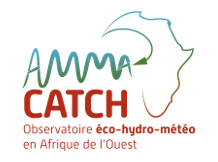Scientific objectives
The AMMA-CATCH observatory is organized according to three main thematic axes which allow scientific animation and guide the observation strategy, plus a methodological axis dedicated to the evolution of devices and instrumentation :
- The multi-decadal trends of hydro-climatic hazards (past and projections) in particular the regimes of precipitation, flow, temperature, as well as the evolution of extremes.
- The dynamics of vegetation, land use and their interactions with the water cycle, both by in situ monitoring (evapotranspiration and CO2 fluxes, LAI, water content, nitrogen, phosphorus in soils, ...) and by remote sensing.
- The trajectories of water resources, in particular the quantification of stocks, recharge and aquifer / river exchanges for groundwater, monitoring of ponds, and their qualities, all in connection with uses and demand for this resource.
- Metrology, technological watch and innovation for observation in intertropical zones : the researchers, engineers and technicians together develop a unique expertise in the observation techniques that they are keen to share and animate with the partners.
To achieve these objectives, since 1990 the observatory has been collecting data from three highly instrumented mesoscale sites, staggered from North to South West Africa, in different eco-climatic zones (Benin, Niger, Mali). Since 2016, AMMA-CATCH has relied on additional sites (Senegal and Niger), built on partnerships, in order to measure the latitudinal gradient, and its variability in longitude.
Updated on 26 janvier 2022




